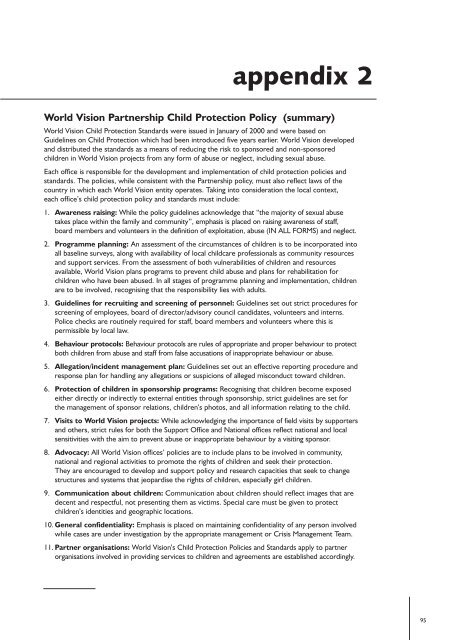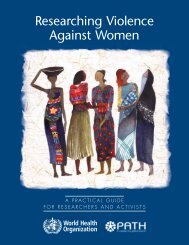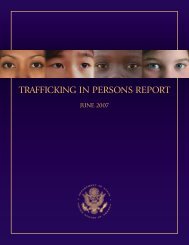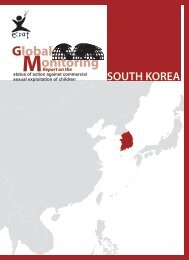Download PDF - Violence Against Children - East Asia and the ...
Download PDF - Violence Against Children - East Asia and the ...
Download PDF - Violence Against Children - East Asia and the ...
You also want an ePaper? Increase the reach of your titles
YUMPU automatically turns print PDFs into web optimized ePapers that Google loves.
appendix 2<br />
World Vision Partnership Child Protection Policy (summary)<br />
World Vision Child Protection St<strong>and</strong>ards were issued in January of 2000 <strong>and</strong> were based on<br />
Guidelines on Child Protection which had been introduced five years earlier. World Vision developed<br />
<strong>and</strong> distributed <strong>the</strong> st<strong>and</strong>ards as a means of reducing <strong>the</strong> risk to sponsored <strong>and</strong> non-sponsored<br />
children in World Vision projects from any form of abuse or neglect, including sexual abuse.<br />
Each office is responsible for <strong>the</strong> development <strong>and</strong> implementation of child protection policies <strong>and</strong><br />
st<strong>and</strong>ards. The policies, while consistent with <strong>the</strong> Partnership policy, must also reflect laws of <strong>the</strong><br />
country in which each World Vision entity operates. Taking into consideration <strong>the</strong> local context,<br />
each office’s child protection policy <strong>and</strong> st<strong>and</strong>ards must include:<br />
1. Awareness raising: While <strong>the</strong> policy guidelines acknowledge that “<strong>the</strong> majority of sexual abuse<br />
takes place within <strong>the</strong> family <strong>and</strong> community”, emphasis is placed on raising awareness of staff,<br />
board members <strong>and</strong> volunteers in <strong>the</strong> definition of exploitation, abuse (IN ALL FORMS) <strong>and</strong> neglect.<br />
2. Programme planning: An assessment of <strong>the</strong> circumstances of children is to be incorporated into<br />
all baseline surveys, along with availability of local childcare professionals as community resources<br />
<strong>and</strong> support services. From <strong>the</strong> assessment of both vulnerabilities of children <strong>and</strong> resources<br />
available, World Vision plans programs to prevent child abuse <strong>and</strong> plans for rehabilitation for<br />
children who have been abused. In all stages of programme planning <strong>and</strong> implementation, children<br />
are to be involved, recognising that <strong>the</strong> responsibility lies with adults.<br />
3. Guidelines for recruiting <strong>and</strong> screening of personnel: Guidelines set out strict procedures for<br />
screening of employees, board of director/advisory council c<strong>and</strong>idates, volunteers <strong>and</strong> interns.<br />
Police checks are routinely required for staff, board members <strong>and</strong> volunteers where this is<br />
permissible by local law.<br />
4. Behaviour protocols: Behaviour protocols are rules of appropriate <strong>and</strong> proper behaviour to protect<br />
both children from abuse <strong>and</strong> staff from false accusations of inappropriate behaviour or abuse.<br />
5. Allegation/incident management plan: Guidelines set out an effective reporting procedure <strong>and</strong><br />
response plan for h<strong>and</strong>ling any allegations or suspicions of alleged misconduct toward children.<br />
6. Protection of children in sponsorship programs: Recognising that children become exposed<br />
ei<strong>the</strong>r directly or indirectly to external entities through sponsorship, strict guidelines are set for<br />
<strong>the</strong> management of sponsor relations, children’s photos, <strong>and</strong> all information relating to <strong>the</strong> child.<br />
7. Visits to World Vision projects: While acknowledging <strong>the</strong> importance of field visits by supporters<br />
<strong>and</strong> o<strong>the</strong>rs, strict rules for both <strong>the</strong> Support Office <strong>and</strong> National offices reflect national <strong>and</strong> local<br />
sensitivities with <strong>the</strong> aim to prevent abuse or inappropriate behaviour by a visiting sponsor.<br />
8. Advocacy: All World Vision offices’ policies are to include plans to be involved in community,<br />
national <strong>and</strong> regional activities to promote <strong>the</strong> rights of children <strong>and</strong> seek <strong>the</strong>ir protection.<br />
They are encouraged to develop <strong>and</strong> support policy <strong>and</strong> research capacities that seek to change<br />
structures <strong>and</strong> systems that jeopardise <strong>the</strong> rights of children, especially girl children.<br />
9. Communication about children: Communication about children should reflect images that are<br />
decent <strong>and</strong> respectful, not presenting <strong>the</strong>m as victims. Special care must be given to protect<br />
children’s identities <strong>and</strong> geographic locations.<br />
10. General confidentiality: Emphasis is placed on maintaining confidentiality of any person involved<br />
while cases are under investigation by <strong>the</strong> appropriate management or Crisis Management Team.<br />
11. Partner organisations: World Vision’s Child Protection Policies <strong>and</strong> St<strong>and</strong>ards apply to partner<br />
organisations involved in providing services to children <strong>and</strong> agreements are established accordingly.<br />
95

















